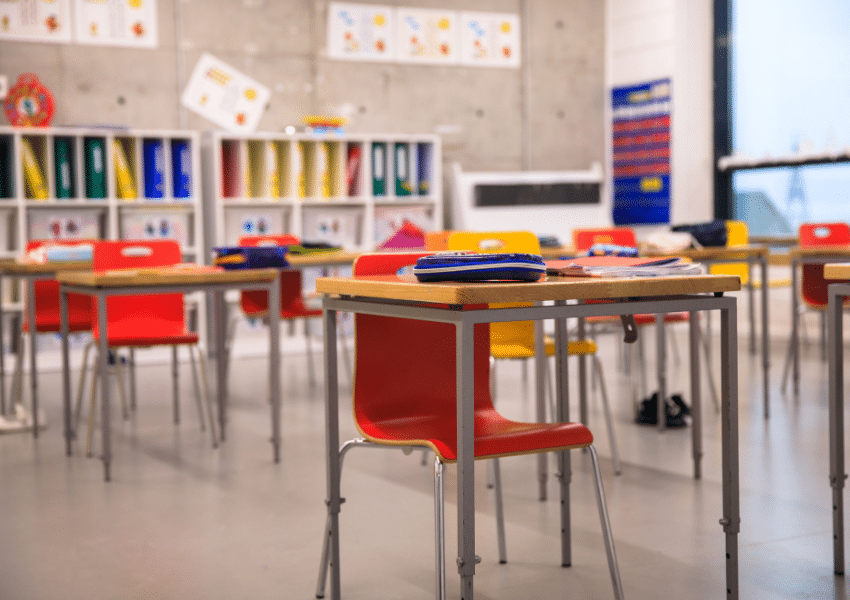You’ve got the keys, the blank slate, and a million Pinterest ideas—now what? If you’ve ever rearranged your classroom 14 times only to end up where you started or discovered that nothing will stick to your cinderblock walls, you’re not alone. Setting up your classroom is part science, part art, and part survival skills. Here’s how to make your space functional, organized, and ready for your best school year yet.
1. Start with a Floor Plan—on Paper
Save your back (and your sanity) by planning before you push a single desk. Measure your room and create a layout in Canva so you can test different setups—rows, clusters, flexible seating zones—without breaking a sweat. Keep the file handy so you can tweak it later in the year. Bonus: Take a stroll through your coworkers’ classrooms for fresh inspiration.
2. Be Strategic with Your Teacher’s Desk
Don’t just plop your desk in the front of the room because “that’s where it goes.” Think sight lines—you want to be able to see everyone from where you sit. Consider angling your desk in a corner and blocking the space behind it with brightly colored floor tape (students will quickly learn that’s a “no-go” zone). Check the view from the back of the room before committing.
3. Create a Teaching Station
Your teaching station is home base for lessons—a spot where your day’s materials are ready to grab. This could be part of your desk, or better yet, a separate area that keeps supplies organized and within reach. The less time you spend hunting for markers, the more time you have for teaching.
4. Master the Art of Storage
Clutter = chaos. Designate clear zones for students to pick up materials and turn in work. Keep frequently used items like pencils and paper within easy reach to reduce downtime. Use a labeling system for bins and shelves so everyone knows where things belong.
5. Tame the Tech
Before you finalize your setup, check outlet locations and plan how devices will be stored, charged, and returned. Use small strips of colored electrical tape to match devices with their chargers and spots at the charging station. Limited colors? Add patterns like stripes to stretch your system further.
6. Turn Down the Volume
A quieter classroom helps everyone focus. Add rubber feet to movable furniture, place rugs in high-traffic areas, and use soft materials to absorb sound. Even a few strategic changes can cut down on echoes and background noise. Consider a relaxing classroom playlist to set the stage for learning.
7. Bring in Nature
Plants make a classroom feel more welcoming—and some even improve air quality. Choose low-maintenance varieties and place them where they’ll get a little love (and not become a dodgeball target).
8. Keep Walls Calm but Useful
Over-decorated walls can overstimulate students. Researchers suggest keeping 20–50% of your wall space clear. Use posters and bulletin boards as teaching tools—refer to them often, update them, and place high-value content where students can see it daily.
- “Paper” your bulletin boards with fabric for a hole-free, year-round backdrop.
- Hot glue clothespins to tacks for easy swapping of posters or vocabulary words.
- Put painter’s tape on walls. Then hot glue posters to the tape for an easy attachment and clean removal.
- Hang clear sheet protectors for student work displays—slide papers in and out or insert blank pages to turn them into reusable whiteboards.
9. Prioritize Prime Real Estate
The front of the room is your VIP zone. Use it for systems students will interact with every day—like bathroom check-ins, absent work folders, or daily instructions. Put permanent displays in hard-to-reach spots and seasonal ones where you can easily swap them.
10. Make Friends with the Custodian
This might be the most valuable tip of all. Learn their name, their birthday, and yes, maybe even their cell number. The day you lock your keys inside your classroom, you’ll be glad you did.
A little planning goes a long way in creating a classroom that works for you and your students. The goal isn’t Pinterest perfection—it’s a space where learning flows, chaos is minimal, and you can focus on what matters most: teaching.
Classroom completed? Check out our Back-to-School Checklist for Busy Teachers and tips for time management.
This article is furnished by California Casualty, providing auto and home insurance to educators, law enforcement officers, firefighters, and nurses. Get a quote at 1.866.704.8614 or www.calcas.com.
- Tires 101: Rotation, Alignment and Balancing Explained - December 22, 2025
- Holiday Fire Safety Tips - December 16, 2025
- Party Potluck Recipes - December 11, 2025

